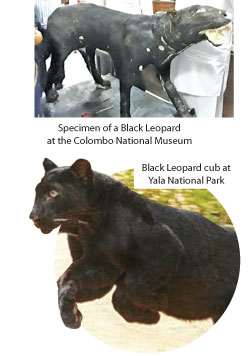
Black Leopards – only 1 in 300 leopards:
Several records of Black Leopards from Yala:
All measures taken to protect the cub:
 The Sri Lankan Leopard (Panthera pardus kotiya) is a leopard subspecies native to Sri Lanka and has been considered a vulnerable species according to the IUCN (International Union for the Conservation of Nature) Red List since 2020.
The Sri Lankan Leopard (Panthera pardus kotiya) is a leopard subspecies native to Sri Lanka and has been considered a vulnerable species according to the IUCN (International Union for the Conservation of Nature) Red List since 2020.
According to data from the Department of Wildlife, 106 leopards have died in Sri Lanka due to human activities since 2010. A census carried out in 2015 found that 700 - 950 leopards are living in the country.
Research
The Yala National Park, is one of the favourite haunts of leopard enthusiasts. Research has found the presence of at least 100 leopards in Yala block 1 alone. Visitor numbers to Yala have now further increased almost to unbearable levels after a black leopard was spotted on March 24.
Previously, a black leopard was seen in the forest area in Sri Pada after it was caught on a trap camera by Dr. Malaka Abeywardana and Manoj Akalanka from the Department of Wildlife.
According to Dr. Abeywardana, only one in 200 or 300 leopards in Sri Lanka are black, due to the presence of a recessive gene. Four black leopards have died in recent times after getting caught in traps set up by humans.
Dr Abeywardana said the best areas for such leopards to live and hunt in as well as be protected are rainforests.
But Yala is not an ideal environment for a black leopard to thrive in, increasing the threats to its well being. According to Yala Park Warden Manoj Widyaratne, there is now a greater influx of visitors to the park after the leopard sighting.
“This is the first time in history that a black leopard was seen in Yala. The young black male leopard cub was seen with his mother, crossing the Jamburagala road in the Yala Block 1 between 8 - 9 a.m.” he said.
Seelawa Tank
“There have been reports of black leopards from Yala Block 3 but these sightings were never confirmed with footage. A ranger recently reported that a female leopard was seen crossing the Seelawa Tank with two black leopard cubs. Perhaps this could be one of those cubs,” he said. The first sighting of the black cub in Yala Block 1 was witnessed by two safari jeep drivers and tourists on February 24.
“The group said it was unclear but claimed the cub could have been black. The clear sighting took place many days later. It is believed the cub is around 6-7 months old. The female leopard identified as the mother is known to be shy and fond of remaining isolated,” he said.
 According to him, the cub’s colour could be a disadvantage for its survival. “Male cubs are prone to being killed by male leopards due to territory issues. A cub was killed in the same area two months ago. Visitors have now been blocked from visiting the area the cub was found in as the day after the sighting a large number of jeeps and visitors converged on the area,” he said.
According to him, the cub’s colour could be a disadvantage for its survival. “Male cubs are prone to being killed by male leopards due to territory issues. A cub was killed in the same area two months ago. Visitors have now been blocked from visiting the area the cub was found in as the day after the sighting a large number of jeeps and visitors converged on the area,” he said.
“Therefore, entry has been banned temporarily till security measures are imposed for the cub’s safety,” he said. The Park warden said this was done to prevent the mother moving the cub to a less crowded area which could lead them to an area close to human settlements where traps are common, thereby risking the life of the cub.
Scientists say that the black coat is fairly common in various cat species including the domestic cat. However, in this case it is a rare occurrence. “In this particular case, the AFIP gene is believed to have been mutated. Therefore, it is not a separate sub-species, but a leopard having a coat with a different colour.
It can easily adapt to its environment,” said Dr. Nilanthi Rajapakse, who has conducted genetic research on the wild leopard population in Sri Lanka.
Wildlife and Nature Conservation Society (WNCS) President Spencer Manuelpillay has commenced the move. According to him it is up to the people to protect the black leopard cub. “Some Sri Lankans spend a significant amount of money to visit Kabini in India to see the black leopards found there. At times they are not lucky enough to see one. Therefore this animal is a blessing to us and we must take steps to protect it,” he said. He commended the Department for closing down the area and suggests that vehicles must only be allowed to travel in single file in the area and that too only during a specific time. “If these measures are not imposed the cub might escape to another area,” he said. Then its fate cannot be predicted.
